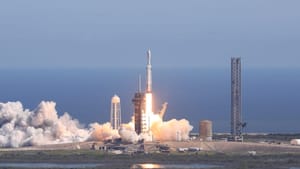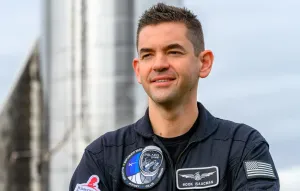
Oct 14, 2024
Europa Clipper begins journey to Jupiter atop Falcon Heavy
At 16:06 pm Universal Coordinated Time, Europa Clipper began its long journey to Europa, one of Jupiter's moons, from Launch Complex 39A, in Florida. Launch lasted for almost an hour to escape Earth's gravity, with the spacecraft separating from Falcon Heavy's second-stage at T+1:02:39.
Now in space, Europa Clipper is beginning its long trek to Europa. In February 2025 the spacecraft will perform a gravity assist with Mars, followed by one with Earth in December 2026. A few years later, the spacecraft will arrive at Jupiter in April of 2030. The first flyby of Europa is expected in the spring of 2031.
Falcon Heavy lifts off from pad 39A in Florida for the 11th time! pic.twitter.com/tcZu1LOOOm
— SpaceX (@SpaceX) October 14, 2024
Falcon Heavy lifting off from Launch Complex 39A carrying Europa Clipper, via SpaceX on X.
Ahead of successful spacecraft deployment, NASA Administrator Bill Nelson said:
"Today, we embark on a new journey across the solar system in search of the ingredients for life within Jupiter's icy moon." – "Our next chapter in space exploration has begun."
Supporting the launch of Europa Clipper was SpaceX's Falcon Heavy rocket, the most capable commercial launch vehicle currently in service. To give the spacecraft all of the speed it needed, Falcon Heavy was flying in a fully expendable configuration. Usual Falcon Heavy missions would have had the two side boosters return to Cape Canaveral.
The boosters flying for this Falcon Heavy mission were B1089, flying for the first time, B1065, flying for the sixth time, and B1064, also flying for the sixth time. This was also the eleventh flight of SpaceX's Falcon Heavy launch vehicle.
What is Europa Clipper?
Europa Clipper is a NASA exploration mission to Jupiter's moon Europa. The spacecraft will take approximately five and a half years to reach Europa, where it will search for possible signs of life. NASA's main objectives for the mission are as follows: Investigate Europa’s Composition, Characterize the Geology of Europa, Determine the Thickness of Europa’s Icy Shell & How the Ocean Interacts With the Surface.

NASA states that the spacecraft will orbit Jupiter and conduct forty-nine flybys of Europa over its planned four-year mission. Europa Clipper won't orbit Europa itself due to the extreme radiation environment.
Onboard the spacecraft are a handful of scientific instruments. They are: SUrface Dust Analyzer (SUDA), MAss Spectrometer for Planetary EXploration/Europa (MASPEX), Radar for Europa Assessment and Sounding: Ocean to Near-surface (REASON), Plasma Instrument for Magnetic Sounding (PIMS), Europa Clipper Magnetometer (ECM), Mapping Imaging Spectrometer for Europa (MISE), Europa Ultraviolet Spectrograph (Europa-UVS), Europa Thermal Emission Imaging System (E-THEMIS), and Europa Imaging System (EIS). Europa Clipper will also use its radio antenna to perform experiments to study the moon's gravitational field. More details about these instruments are available here.
What is Falcon Heavy?
Falcon Heavy is the super-heavy lift variant of SpaceX's extremely reliable Falcon-9 rocket. Like the single-core Falcon 9, it is also partially reusable.
SpaceX claims that Falcon Heavy can send up to 63,800 kilograms to low Earth orbit and 26,700 kilograms to geosynchronous transfer orbit when fully expended, or 8,000 kilograms to geosynchronous transfer orbit when all three cores are reused.

Falcon Heavy's boosters, first, and second stages are powered by SpaceX's Merlin 1D engines, burning rocket-grade kerosene and liquid oxygen. The boosters, each equipped with nine engines, generate a combined thrust of 1,542 tons for up to two minutes and thirty-four seconds. The first-stage also utilizes nine engines, producing 771 tons of thrust for up to three minutes and seven seconds. Combined the boosters and first-stage have a maximum thrust of 2,313 tons. Meanwhile, the second-stage is powered by a single Merlin 1D vacuum engine generating 95 tons of thrust.
For recovery, each booster, and sometimes the first stage, has four grid fins and four landing legs. The boosters either land vertically on a drone ship or on a landing pad back at its launch site, landing back at the launch site causes a reduction it payload capacity.
On the pad, the rocket is 70 meters tall with the first and second stages 3.7 meters in diameter as well as the boosters, with the booster attached the rocket has a width of 12.2 meters. The fairing is 5.2 meters in diameter and tapers out from the top of the second-stage. Fully fuelled Falcon Heavy weighs approximately 1,420,000 kilograms.



